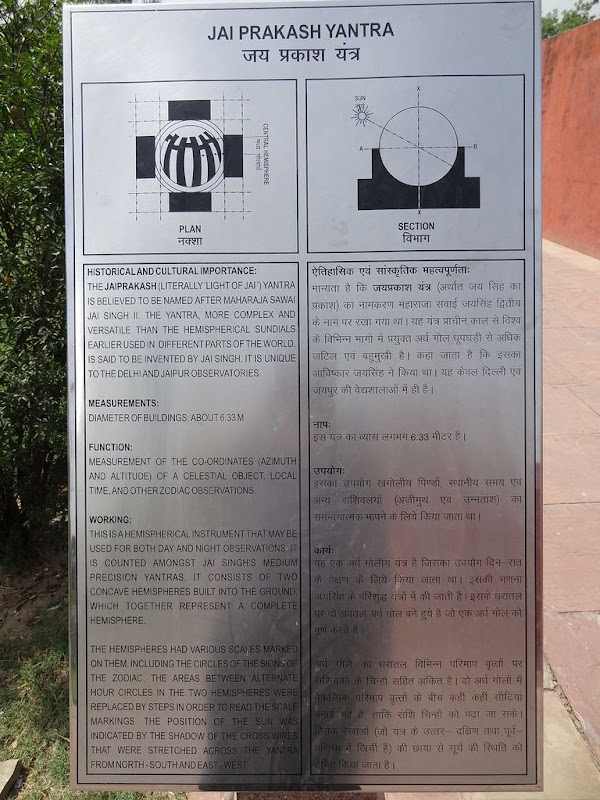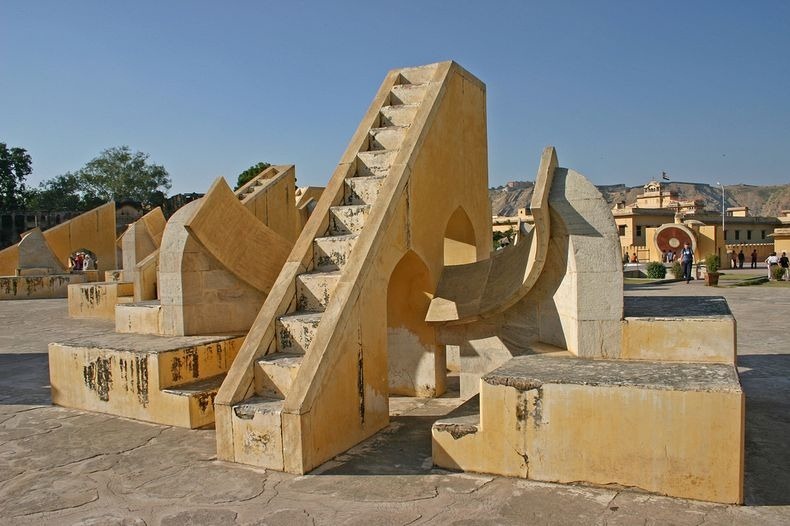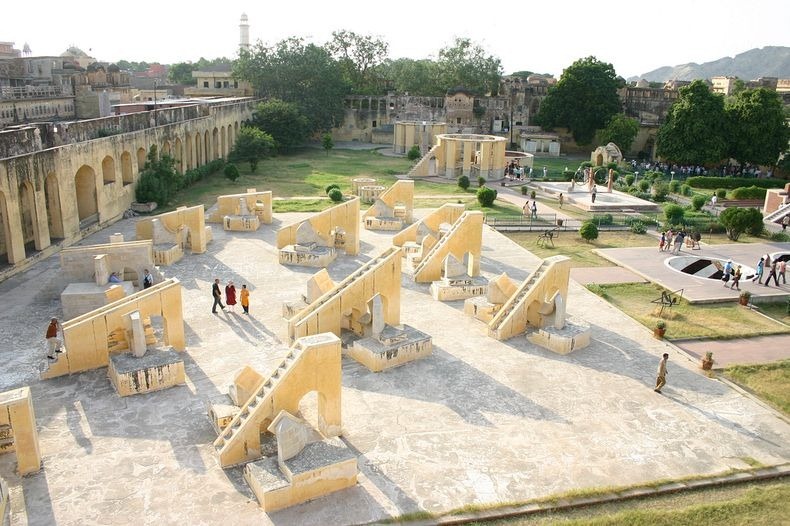Jantar Mantar - Ancient Astronomical Observatories of India
Between 1727 and 1734 Maharajah Jai Singh II of Jaipur, India,
constructed five astronomical observatories in his native territory of
west central India. The observatories called "Jantar Mantars"
incorporate multiple buildings of unique form, each with a specialized
function for astronomical measurement. These structures with their
striking combinations of geometric forms at large scale, have captivated
the attention of architects, artists, and art historians world wide,
yet remain largely unknown to the general public. Passionately
interested in mathematics and astronomy, Jai Singh adapted and added to
the designs of earlier sight-based observatories to create an
architecture for astronomical measurement that is unsurpassed. Jai Singh
was influenced primarily by the Islamic school of astronomy, and had
studied the work of the great astronomers of this tradition. Early Greek
and Persian observatories contained elements that Jai Singh
incorporated into his designs, but the instruments of the Jantar Mantar
are more complex, or at a much greater scale than any that had come
before, and in certain instances, are completely unique in design and
function.

Photo credit
Of
the observatories originally built at Delhi, Jaipur, Mathura, Ujjain,
and Varanasi, all but the Mathura observatory still exist. The condition
of the instruments varies, due to the ravages of weather and lack of
maintenance over time, but the observatories at Jaipur and Ujjain have
have had considerable restoration, and repairs have been made from time
to time at each of the sites. The Jaipur observatory is the largest and
best preserved of these. It has been inscribed on the World Heritage
List as "an expression of the astronomical skills and cosmological
concepts of the court of a scholarly prince at the end of the Mughal
period".
The Jaipur observatory consist of 14 major geometric devices for measuring time, predicting eclipses, tracking stars' location as the earth orbits around the sun, ascertaining the declinations of planets, and determining the celestial altitudes and related ephemerides. The Samrat Yantra, the largest instrument, is a sun dial 27 meter high, its shadow carefully plotted to tell the time of day. The Samrat Yantra can be used to tell the time to an accuracy of about two seconds. Its shadow moves visibly at 1 mm per second, or roughly a hand's breadth (6 cm) every minute, which can be a profound experience.
The Jay Prakash may well be Jai Singh’s most elaborate and complex instrument. It consists of hollowed out hemispheres with markings on their concave surfaces. Crosswires were stretched between points on their rim. From inside the sphere, an observer could align the position of a star with various markings or a window's edge. The structure is based on concepts dating to as early as 300 B.C. when the Greco-Babylonian astronomer Berosus is said to have made a hemispherical sundial. Hemispherical dials also appear in European Church architecture during the Middle Ages, and at the observatory in Nanking, China in the late 13th-century. The Jai Prakash, however, is much more elaborate, complex, and versatile than any of its predecessors.
Other instruments include the Ram Yantra whose primary function is to measure the altitude and azimuth of celestial objects, including the sun, and the Shasthansa Yantra which gives extremely accurate measurements of the zenith distance, declination, and diameter of the sun. The Mishra Yantra which are able to indicate when it was noon in various cities all over the world and was the only structure in the observatory not invented by Jai Singh II.
Today the observatories are popular tourist attraction. However, local astronomers still use it to predict the weather for farmers, although their authority is becoming increasingly questionable. Students of astronomy and Vedic astrology are required to take some of their lessons at the observatory, and it can be said that the observatory is the single most representative work of Vedic thought that still survives, apart from the texts.

Photo credit

Photo credit

Photo credit

Photo credit

Photo credit

Photo credit

Photo credit

Photo credit

Photo credit

Photo credit

Photo credit

Photo credit

Photo credit

Photo credit

Photo credit

Photo credit

Photo credit

Photo credit
Sources: Wikipedia, Jantarmantar

Photo credit
The Jaipur observatory consist of 14 major geometric devices for measuring time, predicting eclipses, tracking stars' location as the earth orbits around the sun, ascertaining the declinations of planets, and determining the celestial altitudes and related ephemerides. The Samrat Yantra, the largest instrument, is a sun dial 27 meter high, its shadow carefully plotted to tell the time of day. The Samrat Yantra can be used to tell the time to an accuracy of about two seconds. Its shadow moves visibly at 1 mm per second, or roughly a hand's breadth (6 cm) every minute, which can be a profound experience.
The Jay Prakash may well be Jai Singh’s most elaborate and complex instrument. It consists of hollowed out hemispheres with markings on their concave surfaces. Crosswires were stretched between points on their rim. From inside the sphere, an observer could align the position of a star with various markings or a window's edge. The structure is based on concepts dating to as early as 300 B.C. when the Greco-Babylonian astronomer Berosus is said to have made a hemispherical sundial. Hemispherical dials also appear in European Church architecture during the Middle Ages, and at the observatory in Nanking, China in the late 13th-century. The Jai Prakash, however, is much more elaborate, complex, and versatile than any of its predecessors.
Other instruments include the Ram Yantra whose primary function is to measure the altitude and azimuth of celestial objects, including the sun, and the Shasthansa Yantra which gives extremely accurate measurements of the zenith distance, declination, and diameter of the sun. The Mishra Yantra which are able to indicate when it was noon in various cities all over the world and was the only structure in the observatory not invented by Jai Singh II.
Today the observatories are popular tourist attraction. However, local astronomers still use it to predict the weather for farmers, although their authority is becoming increasingly questionable. Students of astronomy and Vedic astrology are required to take some of their lessons at the observatory, and it can be said that the observatory is the single most representative work of Vedic thought that still survives, apart from the texts.

Photo credit

Photo credit

Photo credit

Photo credit

Photo credit

Photo credit

Photo credit

Photo credit

Photo credit

Photo credit

Photo credit

Photo credit

Photo credit

Photo credit

Photo credit

Photo credit

Photo credit

Photo credit
Sources: Wikipedia, Jantarmantar